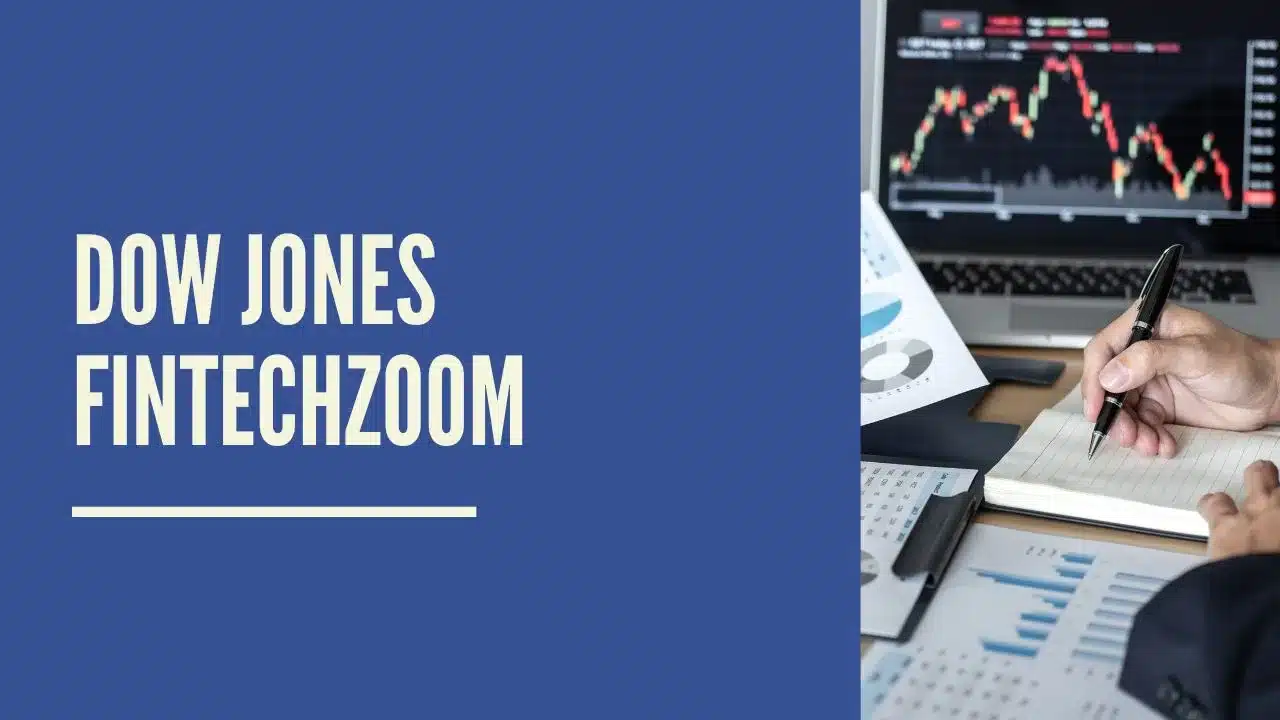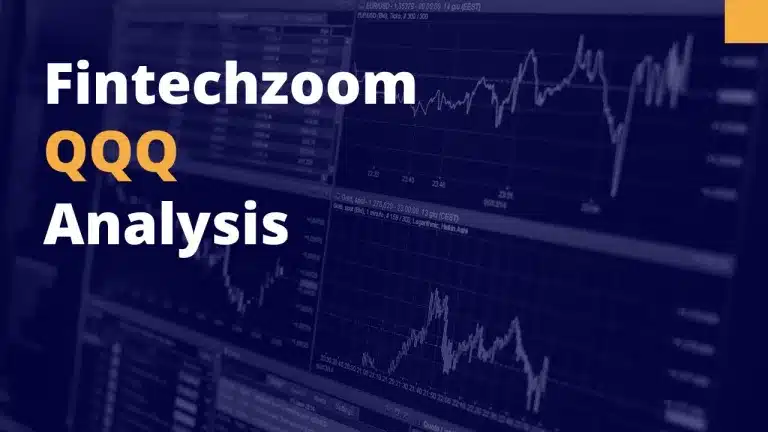Dow Jones Fintechzoom: Key Insights and Strategies for Investors
In this analysis on Fintechzoom, we’ll analyze Dow Jones historical performance, current performance, and future outlook. So, if you are thinking of investing in Dow Jones stocks, read this guide completely.
The Dow Jones Industrial Average (DJIA) stands as one of the most watched stock indices in the world, often referred to simply as “the Dow.” This index, which was established in 1896 by Charles Dow, represents the stock performance of 30 prominent companies listed on stock exchanges in the United States including giants like Amazon and Disney. Serving as a barometer for the overall health of the US stock market and the economy, the Dow Jones is integral to both investors’ strategies and the economic indicators used by policymakers.
The Dow’s relevance comes from its ability to reflect significant economic events through the performance of these major companies. Over the years, its movements have been closely correlated with economic expansions, recessions, and recoveries, providing valuable insights into the broader market trends. For investors, understanding the dynamics of the Dow Jones is crucial as it can influence investment decisions and portfolio management across global financial markets.
Dow Jones Historical Overview
The Dow Jones Industrial Average has experienced a transformative journey since its inception in 1896. Initially starting with just 12 stocks, the Dow was devised to give a clear picture of the business environment by tracking industrial companies’ stock performances, representing the backbone of the U.S. economy. Over time, the Dow expanded to include 30 significant companies, encompassing a broad spectrum of industries from finance to technology, reflecting broader economic changes.
The early 20th century was a period of rapid industrial growth in the United States, and the Dow mirrored this expansion. Remarkably, the index rose from 68 points in 1900 to over 300 points by the late 1920s, highlighting the economic boom of the era. However, the Great Depression brought about a significant downturn, with the Dow plummeting to a mere 41 points in 1932. This dramatic drop underscored the severity of the economic crisis.
Post World War II, the Dow began a long climb, reflecting the economic prosperity of the 1950s and 1960s. By 1972, it reached the 1,000 point milestone, signifying the robust economic conditions of the time. The late 20th and early 21st centuries saw further milestones, with the Dow crossing 10,000 points in 1999 amid the dot-com boom and later reaching 20,000 in 2017, driven by strong corporate earnings and economic optimism.
Throughout its history, the Dow has not only provided a snapshot of the prevailing economic conditions but also offered insights into the potential future direction of the market. These historical trends serve as a critical tool for investors looking to understand market cycles and make informed investment decisions.
Fintechzoom Current Performance Analysis of Dow Jones

In recent times, the Dow Jones Industrial Average has demonstrated notable volatility, reflective of both global economic uncertainties and domestic fiscal policies. As of early 2024, the Dow has been navigating through various economic pressures, including changes in U.S. monetary policy, trade tensions, and global economic slowdowns, which have all contributed to its fluctuating performance.
For instance, on a typical trading day, such as February 20, 2024, the Dow opened at 38,576.26, reached a high of 38,663.09, and dipped to a low of 38,460.20 before closing at 38,563.80. This day’s activity, characterized by a narrow range and moderate volume of 335,990,000 shares, is indicative of the cautious investor sentiment prevailing at that time.
Over the last month, the Dow has seen days with wider fluctuations, highlighting increased investor anxiety around major economic announcements or geopolitical events. The index’s performance can swing significantly based on quarterly earnings reports of its constituent companies or shifts in economic policy announced by the Federal Reserve. For example, announcements regarding interest rate hikes or trade policy adjustments have historically led to sharp movements in the Dow.
These recent trends underscore the importance of staying informed about current events for investors looking to manage their portfolios effectively. The Dow’s daily performance offers critical insights into the broader market dynamics, helping investors make timely decisions in an ever-changing economic landscape.
Fintechzoom Dow Jones Year-by-Year Performance Analysis
The year-by-year performance of the Dow Jones Industrial Average offers valuable insights into its behavior over extended periods, helping investors recognize patterns and cycles that influence investment strategies. This section reviews the annual performance over recent years, focusing on the variability and drivers behind significant changes.
In 2021, the Dow experienced a strong upward trajectory, influenced by the economic recovery post-COVID-19 pandemic lows. The index saw a yearly gain of approximately 18.7%, closing the year at 36,338.30, buoyed by strong corporate earnings and an aggressive fiscal and monetary policy response to the pandemic. This rebound was indicative of investor confidence in a robust economic recovery.
Contrastingly, 2022 presented more challenges. Global supply chain issues, inflationary pressures, and tightening monetary policies led to increased market volatility. The Dow’s performance was muted, with a modest year-end gain of 5.9%, reflecting the cautious stance of investors amid economic uncertainties.
The beginning of 2023 saw a mix of optimism and caution, with the Dow showing signs of struggle under continued inflation concerns and interest rate hikes, yet managing to gain due to strategic corporate performances and technological advancements within its leading sectors. By mid-2023, the index fluctuated but showed resilience, indicating the complex interplay of economic forces affecting market sentiment.
This detailed look into the annual performance not only helps in understanding the macroeconomic factors affecting the index but also aids investors in identifying long-term trends for strategic planning.
What Factors Influence Dow Jones?
The performance of the Dow Jones Industrial Average is significantly influenced by a variety of economic factors that range from macroeconomic policies to global events. Understanding these factors can provide investors with insights into potential future movements of the index.
Interest Rates and Monetary Policy
The Federal Reserve’s monetary policy significantly drives the Dow’s performance. For example, lowering interest rates generally reduces borrowing costs, which encourages spending and investment, thereby lifting stock markets, including the Dow. Conversely, rate hikes often lead to reduced spending and investment, which can weigh on stock prices. Recent shifts in the Fed’s stance have frequently led to volatility in the Dow.
Economic Indicators
Various economic indicators, such as unemployment rates, GDP growth, and consumer confidence, also play crucial roles. High unemployment can erode consumer confidence and reduce spending, negatively impacting the corporate profits of Dow constituents. Conversely, strong GDP growth signals a healthy economy, boosting investor sentiment and the stock market.
Global Events
International affairs such as trade wars, geopolitical conflicts, and pandemics can cause significant fluctuations in the Dow. For example, the onset of the COVID-19 pandemic saw the Dow drop sharply due to uncertainty and fear of economic stagnation. However, it recovered as stimulus measures were introduced and corporate earnings began to stabilize.
Corporate Earnings
As the Dow is composed of 30 significant publicly traded companies, their earnings reports are pivotal. Positive earnings reports from these companies can lead to gains in the Dow, while disappointing earnings tend to lead to declines.
Inflation
Inflation is another critical economic factor. Mild inflation can be a sign of growing demand in an expanding economy, which can be positive for stocks. However, high inflation often leads to higher costs and squeezed margins for companies, negatively affecting their stock prices.
By closely monitoring these economic factors, investors can gain a better understanding of potential price movements within the Dow and adjust their investment strategies accordingly.
Dow Jones Fintechzoom Investment Strategies
Investment strategies for navigating the Dow Jones Industrial Average require an understanding of both the market’s historical performance and current economic conditions. Investors can choose from several strategies depending on their risk tolerance, investment horizon, and financial goals.
Long-Term Investment
One common strategy is the long-term buy-and-hold approach. This strategy involves investing in Dow components with a history of stable returns and holding these investments through market fluctuations to benefit from potential long-term growth and dividends. This approach is favored by investors who seek to minimize the risk of short-term volatility and believe in the long-term growth prospects of the U.S. economy.
Short-Term Trading
For more active investors, short-term trading might be appealing. This involves capitalizing on the Dow’s daily or weekly fluctuations. Effective short-term trading requires a good understanding of technical analysis and market indicators to predict future movements. This strategy is riskier and requires more time and attention to manage effectively.
Diversified Investment
Considering the Dow represents only a small selection of the market, investors often use it as part of a diversified investment strategy. By investing in a mix of Dow stocks and other assets, such as bonds, international stocks, or commodities, investors can reduce risk through diversification, as different asset classes often perform differently under various economic conditions.
Sector Rotation
This strategy involves shifting investments among Dow sectors that are expected to perform well during different phases of the economic cycle. For example, investors might favor consumer staples and utilities during economic downturns and switch to consumer discretionary and tech stocks in a booming economy.
Using Market Cycles
Understanding secular market cycles, as discussed in the analysis of historical trends, can also guide investment decisions. During secular bull markets, a strategy of buying and holding stocks can be beneficial, whereas, in bear markets, strategies that focus on capital preservation, such as investing in safer, non-correlating assets, might be more appropriate.
These strategies, when applied thoughtfully, can help investors navigate through the complexities of the stock market, particularly within the framework of the Dow Jones Industrial Average. Each strategy has its own set of risks and benefits, and choosing the right one depends on individual financial circumstances and market conditions.
Sector Performance within the Dow Jones
The Dow Jones Industrial Average is not just a collection of 30 companies; it is a mosaic of various sectors that represent the backbone of the U.S. economy. Understanding how different sectors perform can provide investors with insights into the overall health of the market and help in making informed investment decisions.
Technology Sector
Historically, the technology sector within the Dow has shown significant growth, especially in the digital transformation era. Companies like Apple and Microsoft have seen their values increase dramatically, reflecting the sector’s robust contribution to the index. However, technology stocks can be volatile, reacting sharply to changes in consumer demand, regulatory shifts, and global economic conditions.
Financial Services Sector
This sector includes banks and financial institutions, such as JPMorgan Chase and Goldman Sachs, which tend to benefit from higher interest rates as they can earn more from their loan products. However, during economic downturns, this sector is often hit hard due to increased loan defaults and reduced consumer spending.
Consumer Goods Sector
Companies in this sector, like Coca-Cola and Procter & Gamble, are often considered safe havens during volatile market periods. These companies produce everyday essentials that remain in demand regardless of economic conditions, providing steady dividends and stable performance.
Industrial and Energy Sectors
These sectors include giants like Boeing and ExxonMobil, which economic cycles, geopolitical tensions, and changes in commodity prices can heavily influence. The performance of these stocks often reflects broader economic trends, with growth during economic expansions and potential declines during recessions.
Healthcare Sector
Healthcare companies in the Dow, such as Johnson & Johnson and Merck, tend to be less sensitive to economic downturns compared to other sectors. This is because the demand for healthcare and pharmaceuticals remains consistent, even during economic stress, making this sector a defensive play in times of uncertainty.
Each sector’s performance can significantly affect the overall movement of the Dow Jones Industrial Average. By analyzing sector trends, investors can gauge economic shifts and adjust their portfolios to mitigate risks and capitalize on growth opportunities.
Future Outlook
As we look to the future, the outlook for the Dow Jones Industrial Average hinges on several key factors, including technological advancements, geopolitical events, economic policies, and market sentiment. Forecasting the Dow’s performance requires a nuanced understanding of these elements and their potential impacts on the market.
Technological Innovation
Continued innovation in technology is expected to drive significant changes within industries represented in the Dow. Companies that adapt and integrate new technologies effectively are likely to see substantial growth, positively impacting the index. For instance, advancements in AI, cloud computing, and renewable energy could provide new opportunities for growth in the tech and energy sectors.
Geopolitical Stability
Geopolitical events such as trade agreements, conflicts, and international policy decisions will also play a critical role in shaping market conditions. Stability tends to encourage investment and growth, while uncertainty can cause volatility and pullbacks in the market. Investors should closely monitor global events to anticipate their potential impact on the Dow.
Economic Policies
Fiscal and monetary policies are crucial in steering economic conditions. Decisions by the Federal Reserve on interest rates, for example, will influence investment strategies and stock performance. Similarly, government spending and taxation policies can either boost economic growth or weigh it down, affecting corporate earnings and stock prices.
Market Sentiment
Finally, investor sentiment, driven by overall market perception and future outlooks, can significantly sway the Dow. Positive sentiment can lead to rallies, while negative sentiment can trigger declines. The aforementioned factors often influence sentiment, making it a barometer of current and future expectations.
While the exact trajectory of the Dow Jones Industrial Average is uncertain, investors equipped with a clear understanding of these influencing factors and strategic insights can better navigate future market landscapes. By staying informed and adaptable, investors can position themselves to take advantage of new opportunities and mitigate potential risks.
Frequently Asked Questions (F.A.Q)
What causes the Dow Jones to fluctuate?
The Dow Jones Industrial Average fluctuates due to a variety of factors including changes in economic indicators, corporate earnings reports, shifts in investor sentiment, monetary policy changes, and global events. Economic indicators like GDP growth, unemployment rates, and inflation impact corporate profits and investor confidence, thereby influencing the index. Corporate earnings reflect the health of the 30 major companies listed on the Dow, impacting its performance directly.
How can investors use Dow Jones data to make investment decisions?
Investors use Dow Jones data to gauge the market trend and overall economic health. By analyzing the performance, sectors, and individual stock movements within the Dow, investors can make informed decisions about asset allocation, risk management, and timing their buy or sell actions. The Dow’s performance can also signal broader economic trends, helping investors anticipate market movements.
What are the risks associated with investing in the Dow Jones?
Investing in the Dow Jones carries risks such as market risk, where the value of investments can decline due to economic changes or other events that impact the entire market. Specific risks to the Dow include its limited diversification, as it only includes 30 companies. This can lead to higher volatility if one or several of its heavyweight components experience a downturn. Additionally, geopolitical risks, inflationary pressures, and changes in monetary policy can also affect the Dow’s stability and performance.
Wrapping Up
As we conclude our comprehensive analysis of the Dow Jones Industrial Average, we have explored its historical trends, current performance, economic influences, and strategic approaches for investing. This deep dive has offered a clear window into the complexities of one of the world’s most iconic stock indices and provided actionable insights for both novice and seasoned investors.







